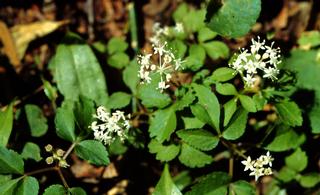
Panax trifolius, Dwarf gensing Photograph by John Pickering



 Scientific and Common Names
Scientific and Common Names
 Identification
Identification
 Geography
Geography
 Natural History
Natural History
 How to Encounter
How to Encounter
 More Images
More Images
 References
References
Scientific and Common Names:
Taxonomic Classification:
| Kingdom | Plantae |
| Division | Magnoliophyta |
| Class | Magnoliopsida |
| Subclass | Rosidae |
| Order | Apiales |
| Family | Araliaceae |
| Tribe | Aralieae |
| Genus | Panax |
| Species | Trifolium |
Common Names:
Reference Where it is Described:
Niering, William A. and Nancy C Olmstead. National Audubon Society Field Guide to North American Wildflowers. New York: Chantieleer Press, 1995.
Scientific Reference which includes the Species within the Identification Key:
Panax trifolium: Leaflets 3, sessile; tuberous root, round
Holotype and Paratype Specimans and Where the Specimans were Collected:
The Sex Changing Dwarf Ginseng:
Identification:
Description of Species:
STAMINATE FLOWER VS. HERMAPHRODITIC FLOWER:
Staminate Flower:
Subconical floral tube surrounds a persistent, reduced, solitary style.
Hermaphroditic Flower:
Cylindrical floral tube fused below to three carpellate inferior ovary which is noticably swollen at its base. Three styles arise from top of the ovary.
Both Flowers:
Five sepals and five petals alternate on lip of the floral tube. Five two called anthers arise from margin of floral tube opposite sepals.
Philbrick, Thomas C. "Contributions to the Reproductive Biology of Panax trifolium L. (Araliaceae). Rhodora. 77:9 (1983): 97-111.
Authority Who Described the Species:
Radford, Albert, Harry Ahles and C. Richie Bell. Manual of Vascular Flora of the Carolinas. Chapel Hill: University of North Carolina Press, 1968.
Could not find this information. I searched a couple of different online Herbariums. I started with the Linneaus collection in the Swedish museum of Natural History, but my species was not there. I was just unable to locate this particular item.
Geography
Overview of Speciman Distribution:
Panax trifolium L.
AREA STATUS REFERENCES
North America:
Continental United States; CanadaYes
Niering and Olmstead 1995;
www.csdl.tamu.edu/FLORA/
Eastern North America:
United States;
Southern Quebec to Nova Scotia CanadaYes Niering and Olmstead 1995;
Philbrick 1983
Southeastern United States:
CT DE GA KY IN MA MD ME MI MN NC NJ NH NY OH PA RI TN VA VT WI WVYes US Department
of Agriculture
Southern Appalachian States:
GA KY MD NC TN VA WVYes US Department
of Agriculture
Coastal Plain No www.metalab.unc.edu
Piedmont Yes www.metalab.unc.edu
Blue Ridge Mountains Yes www.metalab.unc.edu;
Niering and Olmstead 1995
Yes www.metalab.unc.edu;
Niering and Olmstead 1995
Ridge and Valley No Niering and Olmstead 1995;
Schlessman 1996
Cumberland Plateau No Niering and Olmstead 1995;
Schlessman 1996
Georgia Yes UGA Herbarium Specimans
Clarke County, Georgia No UGA Herbarium
Check Out the US distribution of Panax trifolium
Natural History
How to Locate
 Where and When to Find Panax trifolium :
Where and When to Find Panax trifolium :